Let’s start with some frequently used words in families, perhaps used everyday, like, susu, potty, shit and pee


Let’s start with some frequently used words in families, perhaps used everyday, like, susu, potty, shit and pee. I am wondering why these words are not featuring in our Svacchata campaigns. Maybe they couldn’t make them rhyme.
ADVERTISEMENT

BJP President Amit Shah participates in the Swacch Bharat Abhiyan on Thursday. pic/ PTI
In 2003 I began working on Q2P, a film about public toilets. It took me over two years to complete, partly because hardly anyone was discussing toilets then. To find the scattered activists and thinkers working tirelessly on these issues, with little media attention, to arrive at an understanding of the field was difficult. Since then there is much more focus on the issue, and I’m happy our film contributed to this in some measure.
But it’s an issue that will always need addressing and in fact has been several times. Gandhiji’s own articulation about scavenging, caste, toilet cleaning created a certain public discussion. There have been World Bank funds for urban sanitation projects. There have been government shat pratishat rural sanitation schemes. There has, of course, been Sulabh. And a few years ago, Preity Zinta also gave us a sweeping public spaces photo-op. Each iteration has had its insights and blind spots.
While making our film, we saw repeatedly, how most schemes had a common flaw: attitudes that limit imagination.
Unquestioned assumptions about who inhabits public space and how they used it. Stock biases about ‘good’ urban development. An unwillingness to look at problems with a fresh eye, because that means looking at yourself with a fresh eye.
We found much of these development schemes are very concerned with how things look. Like Singapore, like Shanghai, like America. It’s all about the outside, not the inside. One officer explained the imagination behind the squeaky clean Khan market loo thus: a toilet should not look like a toilet. It should look so good that a poor person will feel scared to go inside.
In some sense, the Svacchata branding feels like a turbo remix of the above. Except it would like that any visiting firang and pravasi will want to come inside. India, its cities should look like there is no dirt and certainly, no dirt producing poor. But this is only brushing dirt under the carpet.
As part of the peeing shitting public I do feel like asking the question, can any campaign about cleanliness really afford to not engage with the idea of dirt? The blinding lights of this campaign and its adarsh balak vibe retain a sense of shame about dirt. And we cannot sufficiently tackle something if we feel shame and avoidance of it, instead of looking at it objectively and scientifically.
Where does dirt come from? The Brahmin and the Dalit, the rich and the poor alike produce dirt. But wait, not so alike. Cities, industries, wealthy people produce more — the overflow of our over-consumption. But, we have the money and disproportionate allocation of resources to wash it away or pay people below minimum wage to clear it away. Often these same people are forced to be dirty because they must live in the dirt we co-created: by
ill-managed garbage dumps and seeping sewers.
The campaign is very keen, in fact, on stigmatising dirt and hence absolving some people from confronting their co-creation of it and thinking about a very messy problem.
Shiny, near neurotic talk of cleanliness and Lady Macbethian washing of hands isn’t going to address things anymore than drinking coke will facilitate love, as promised in that great NRI movie Pardes. To really, sincerely do something for the sanitation deprived, the svacchata campaign may have to get its hands a little dirtier.
Paromita Vohra is an award-winning Mumbai-based filmmaker, writer and curator working with fiction and non-fiction. Reach her at www.parodevi.com.
The views expressed in this column are the individual’s and don’t represent those of the paper.
 Subscribe today by clicking the link and stay updated with the latest news!" Click here!
Subscribe today by clicking the link and stay updated with the latest news!" Click here!







